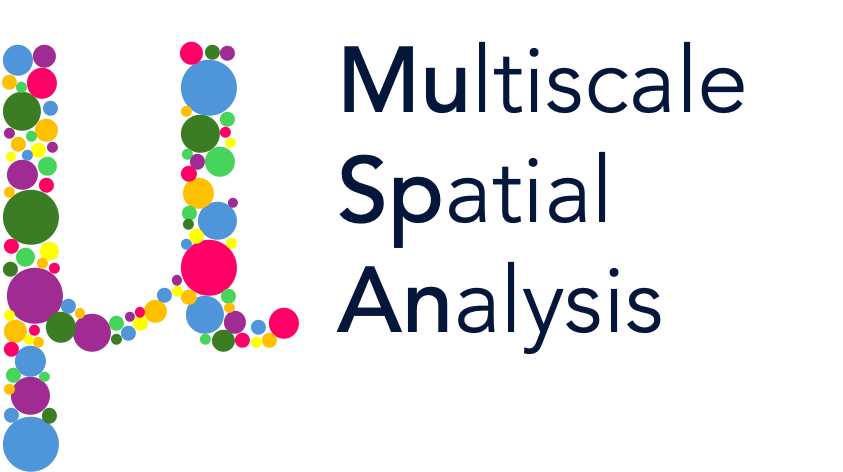The cross pair correlation function (cross-PCF)#
The cross pair correlation function (cross-PCF, also known as the Radial Distribution Function) is a spatial statistic that characterises clustering or exclusion at different length scales. Consider two populations of points, that we’ll call \(A\) and \(B\). Then the cross-PCF, \(g_{AB}(r)\), can be thought of as a ratio describing whether the observed number of pairs of points separated by distance \(r\) (where one is type \(A\) and the other type \(B\)) is higher or lower than would be expected under a statistical null model. In brief, \(g_{AB}(r) > 1\) indicates increased numbers of \(A-B\) pairs separated by distance \(r\), which indicates clustering. \(g_{AB}(r) < 1\) suggests exclusion, or regularity.
Let’s consider some examples.
[1]:
# Import necessary libraries
import numpy as np
import matplotlib.pyplot as plt
import muspan as ms
# Set the resolution for the plots
plt.rcParams['figure.dpi'] = 270
# Load the example domain dataset
domain = ms.datasets.load_example_domain('Synthetic-Points-Aggregation')
# Visualise the domain, coloring points by their cell type
ms.visualise.visualise(domain, color_by='Celltype')
MuSpAn domain loaded successfully. Domain summary:
Domain name: Aggregation
Number of objects: 2000
Collections: ['Cell centres']
Labels: ['Celltype']
Networks: []
Distance matrices: []
[1]:
(<Figure size 2700x2160 with 2 Axes>, <Axes: >)

In this dataset, points of Celltype D are randomly spread across the domain. MuSpAn’s spatial statistics currently compare against a null model of complete spatial randomess (CSR, i.e., assuming that the points are randomly spread throughout the domain). Let’s calculate \(g_{DD}(r)\), the cross-PCF between points of Celltype D and other points of Celltype D. We can visualise the results of this statistic using the visualise_output parameter.
[2]:
# Query the domain for points of Celltype D
pop_D = ms.query.query(domain, ('label', 'Celltype'), 'is', 'D')
# Calculate the cross-PCF for points of Celltype D with themselves
# max_R: maximum radius to consider
# annulus_step: step size for the annulus
# annulus_width: width of the annulus
# visualise_output: whether to visualise the output
r, PCF = ms.spatial_statistics.cross_pair_correlation_function(
domain=domain,
population_A=pop_D,
population_B=pop_D,
max_R=200,
annulus_step=5,
annulus_width=25,
visualise_output=True
)

The black dashed line shows the expected value of \(g_{DD}(r)\) under CSR. In this example, we don’t see a substantial deviation in the cross-PCF away from this value, which makes sense, since the locations of each point in \(D\) are independent of one another.
The other three Celltypes are spatially clustered. Let’s look at all the cross-PCF combinations.
[3]:
# Define the cell types to be analyzed
celltypes = ['A', 'B', 'C', 'D']
# Create a 4x4 subplot for visualizing the cross-PCF for each combination of cell types
fig, axes = plt.subplots(4, 4, figsize=(12, 12))
# Loop through each combination of cell types
for i in range(4):
for j in range(4):
# Calculate the cross-PCF for the current combination of cell types
r, PCF = ms.spatial_statistics.cross_pair_correlation_function(
domain,
('Celltype', celltypes[i]),
('Celltype', celltypes[j]),
max_R=200,
annulus_step=5,
annulus_width=25
)
# Select the current subplot
ax = axes[i, j]
# Plot the cross-PCF
ax.plot(r, PCF)
# Add a horizontal line at y=1 to indicate the CSR baseline
ax.axhline(1, color='k', linestyle=':')
# Set the y-axis limit
ax.set_ylim([0, 7])
# Label the y-axis with the cross-PCF notation
ax.set_ylabel(f'$g_{{{celltypes[i]}{celltypes[j]}}}(r)$')
# Label the x-axis with the distance r
ax.set_xlabel('$r$')
# Adjust the layout to prevent overlap
plt.tight_layout()

